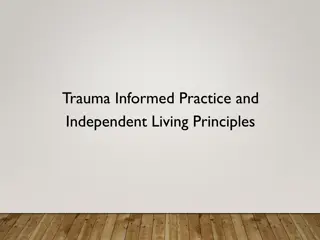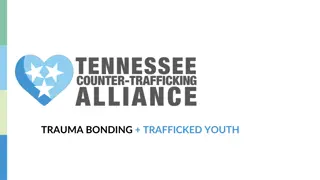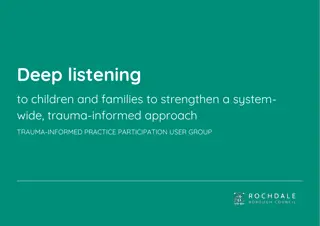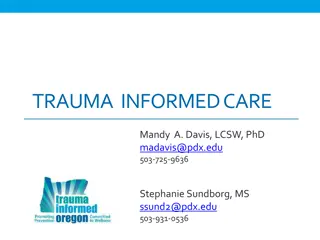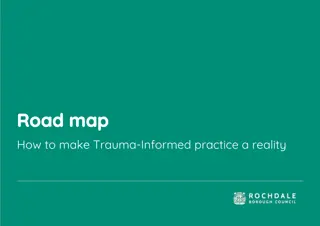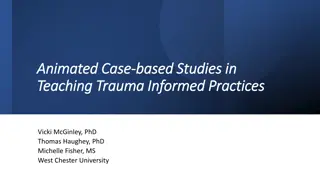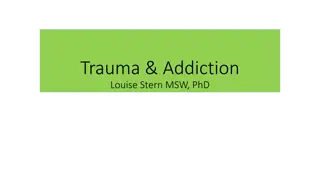Understanding LGBQ & T/GA Youth: Trauma-Informed Approach
Exploring the experiences of LGBQ & T/GA youth through a trauma-informed lens, this symposium delves into terminology related to sexual orientation and gender identity. It covers basics, experiences of youth, trauma fundamentals, and applying trauma-informed approaches to working with diverse youth populations.
Download Presentation

Please find below an Image/Link to download the presentation.
The content on the website is provided AS IS for your information and personal use only. It may not be sold, licensed, or shared on other websites without obtaining consent from the author. Download presentation by click this link. If you encounter any issues during the download, it is possible that the publisher has removed the file from their server.
E N D
Presentation Transcript
Viewing LGBQ & T/GA Youth Through a Trauma Informed Lens Intersections of Equality GEAE Symposium April 30, 2016 Dr. William Koehler, LCSW (wkoehler@edinboro.edu) Dr. Hilary Copp, LSW (hcopp@edinboro.edu) Edinboro University Department of Social Work
Agenda 1. LGBQ & T/GA basics 2. LGBQ & T/GA youth experiences 3. Trauma basics 4. Applying a trauma-informed approach to work with LGBQ & T/GA youth
Terminology: Sexual Orientation LGBQ = lesbian, gay, bisexual, questioning/queer Lesbian: Describes a girl who is attracted to other girls. Gay: Describes a boy who is attracted to other boys. Bisexual: Describes a person who is attracted to both girls and boys (see also: demisexual). Pansexual: Describes a person who is attracted to people across the gender spectrum (beyond male and female).
Sexual Orientation Terminology cont. Queer: An umbrella term that some LGBTQ people use to refer to the entire community. Note: Many people find this term offensive. This is an in-group term only. Questioning: Describes a person who is exploring their own sexual or gender identity. Asexual: Describes a person who is not sexually attracted to anyone. Sometimes referred to as ace.
Terminology: Gender Identity T/GA = Transgender/gender atypical Transgender: An umbrella term for anyone who does not feel that they fit into gender norms; can also be used interchangeably with transsexual. (see also: gender atypical, genderqueer, agender, non- binary) Transsexual: Describes a person who feels like the sex they were assigned at birth does not match the gender they feel inside. Typically individuals who identify as transsexual intend to transition via hormone therapy and/or surgical procedures.
Gender Identity Terminology cont. Genderfluid: Describes a person whose gender identity varies, sometimes from day to day. Increasingly common among youth. Intersex: Describes a person whose genitals are a combination of male and female. Previously known as hermaphrodite, though this term is now considered offensive. Crossdresser/transvestite: Describes a person who wears clothing of the opposite gender for performance or sexual gratification, rather than as an expression of identity. Cisgender: Describes a person whose gender identity matches the gender they were assigned at birth.
2. LGB & T/GA Youth Experiences
Sexual & Gender Identity in Adolescence As of 2010, the average coming-out age was 16 (typically well after coming out to self). Upon coming out to their parents, up to 50% of LGBT teens report a negative reaction, and 26% report being kicked out of their homes. LGBT youth feel unsafe at school because of their sexual orientation (55%) or their gender expression (38%). Three quarters of LGBT students are verbally harassed for their sexual orientation, and approximately half are verbally harassed for their gender expression.
Adolescent Sexual & Gender Identity cont. Approximately half of LGBT students experience cyberbullying (Facebook, text messages, Yik Yak, etc.) based on their sexual orientation and/or gender expression. Two thirds of LGBT students are physically harassed (pushed or shoved) because of their sexual orientation, and a quarter are physically harassed because of their gender expression. Nationally, 16.5% of LGBT students are physically assaulted (punched, kicked, injured with a weapon) because of their sexual orientation, and 11% because of their gender expression.
GLSEN National Survey (2013) Percentages of respondents who heard the following language at school frequently or often Gay used in a negative way: 71% Homophobic remarks like dyke or faggot : 64.5% Gender policing remarks like not masculine/feminine enough : 56% Anti-transgender remarks like tranny or he/she : 33% Teachers or staff making homophobic remarks: 51% Teachers or staff making negative remarks about gender expression: 55.5%
GLSEN Pennsylvania Survey (2011) 8 in 10 LGBT students reported verbal harassment based on their sexual orientation 6 in 10 reported verbal harassment based on their gender expression 2 in 10 reported physical harassment (pushed or shoved) based on gender expression 1 in 10 reported physical assault (punched, kicked, or injured with a weapon) based on sexual orientation
GLSEN Pennsylvania Survey cont. 27% regularly heard staff make negative comments about someone s gender expression; 18% heard staff regularly make homophobic remarks 60% of students who were harassed or assaulted in school never reported it to school staff Of those who did report incidents to school authorities, only 36% said reporting resulted in effective intervention by staff
Local Data In a 2015 survey of 59 teachers from the one middle/high school in the Corry School District: 68% felt that bullying of perceived LGBQ students was a problem in their school 80% felt that bullying of transgender students was a problem in their school 67% have heard a student use LGBT language in a negative way within the past month 11% have witnessed a student physically harm an LGBT student within the past month
Local Data Continued In a 2014 survey of 83 from 12 different middle and high schools in the City of Erie School District: 58% felt that bullying of perceived LGBQ students was a problem in their school 24% felt that bullying of transgender students was a problem in their school (only half (43) identified a trans-student at their school) 75% have heard a student use LGBT language in a negative way within the past month 8% have witnessed a student physically harm an LGBT student within the past month
Comparison of Local Data Corry Teachers (N = 59 ) Erie School District Teachers (N = 83) Bullying of students perceived to be LGBT is a problem at my school 68% 58% Bullying of transgender students is a problem at my school 80%* 24%** I have heard negative LGBT language used at least once in the last month at my school 67% 75% I have seen a student physically harm an LGBT student at least once in the last month at my school 11% 8% * This represents teachers from one combined middle-high school. This school asked us to conduct a training of all of their teachers because a student recently had identified as transgender. ** This represents teachers from a total of 12 different schools. These teachers were attending sessions on bullying or LGBT-specific bullying at a day-long training. Only 43 (52%) of the teachers indicated that there is a student that self- identifies as transgender at their school.
What does this mean? We have LGB and T/GA youth who feel unsafe, are being verbally and physically harassed, and don t know what they can do about it. Multiple studies have shown that this results in higher rates of drug and alcohol abuse, poor grades, truancy, dropping out, and suicide.
The bottom line Youth can t thrive if they don t feel safe. This is not about morality; it s about safety.
Intimate partner violence Police Brutality Sexual abuse Robbery Self-harm Being shot at Witnessing a traumatic event Emotional abuse What is trauma? Bullying Divorce Neglect Tornado Assault Terminal illness Substance using parents Car Crash Rape Bombing Homelessness School violence Combat
Understanding Trauma Universal, regardless of Age Culture Gender Class Sexuality It is determined by events and ongoing situations BUT more importantly It is determined by a person s experience of the event or ongoing situation
Defining Trauma Psychological trauma is an occurrence which is outside the scope of everyday human experience and which would be notably distressing to almost anyone Psychological trauma is the unique individual experience of an event (acute) or enduring conditions (chronic), in which the person: Experienced, witnessed or was confronted with an event(s) that involved actual or threatened deaths or serious injury, or a threat to physical integrity of self/others Person s response involved intense fear, helplessness, or horror. (DSM-5, PTSD and ASD Criteria A)
Trauma Results In Increased: Fight/flight/freeze response Hypervigilance, arousal, paranoia Perceptual and information processing distortions Emotional blunting Aggression and irritability Decreased: Memory processing and retrieval Reality testing Body and emotional awareness Pain tolerance Immune response
Long-Term Effects Exposure to trauma potentially impacts an individual for the rest of their life. Learned helplessness Loss of volume control Action not thought under stress Inability to remember events under stress Dissociation Addiction to stress Trauma-bonding Trauma-reenactment
Wide-Reaching Impact Trauma has a very real and significant impact on: Individuals who experience traumatic events People in relationship with traumatized individuals (couples, families, friends, co-workers, etc.) Service providers working with those individuals Self-care! Communities where traumatic events occur Public health as a whole
4. Applying a trauma-informed approach to work with LGBQ & T/GA youth
The important question is not What s wrong with you? Rather, it s What happened to you?
Guiding Trauma-Informed Principles 1. Safety 2. Trustworthiness 3. Choice 4. Collaboration 5. Empowerment
Trauma-Informed Principles cont. 1. Safety Both physical and emotional Attending to a youth s discomfort or unease What potential triggers are in the youth s environment? 2. Trustworthiness Providing services with clarity and consistency Maintaining healthy interpersonal boundaries Communication/negotiation of service provision
Trauma-Informed Principles cont. 3. Choice Inviting youth to participate in decision-making regarding their environment and their services Building in small choices can make a difference Helping youth have a sense of control 4. Collaboration Communicating respect for life experience and history Communicating respect for youth being the expert on their own experiences Identifying tasks that can be worked on together
Trauma-Informed Principles cont. 5. Empowerment Continually ensuring that youth have some control over their environment and their care Involving youth in change efforts Recognizing strengths and skills Helping youth continue to develop additional skills
Its important to keep in mind that LGBQ & T/GA youth are highly likely to have experienced trauma, including harassment, bullying, assault, parental rejection, and so on. This will affect their behaviors and reactions to subsequent traumatic events.
How YOU Can Be An Ally Ally: Anyone (LGBTQ or not) who supports and stands up for the rights of LGBTQ people Safe space signage Have LGBTQ-inclusive materials in the service environment Welcome transgender and gender-nonconforming youth to use the bathroom that matches their gender identity Routinely use LGBTQ examples (example: families with same-sex parents)
How to Be an Ally cont. Do not assume heterosexuality (For example, instead of asking a girl Do you have a boyfriend? , ask Are you dating anyone? ) Confront homophobic and heterosexist language when others use it With transgender or gender-nonconforming youth, ask for and use their preferred names and pronouns Remember, making mistakes is part of the learning process. Acknowledge and apologize for mistakes, but don t give up!
Thank you! For more information, contact Dr. William Koehler (wkoehler@edinboro.edu) Dr. Hilary Copp (hcopp@Edinboro.edu) Greater Erie Alliance for Equality (greatereriealliance.com)
Resources Local resources: Greater Erie Alliance for Equality greatereriealliance.com/ Northwest Pennsylvania Pride Alliance nwpapride.org Transfamily Erie: Meetings every 4th Saturday from 2-5 at the MHA in downtown Erie Find Transfamily of Erie on Facebook! Meadville: Meetings every 2nd Saturday from 2-5 on the second floor of Counseling Corner, located at 898 Park Avenue in Meadville Transfamily youth: Meetings every 1st Sunday from 2-5 at Lake Erie Counseling in Erie Contact info: Char at 814-504-1507 Closed group on Facebook for youth National resources: The Trevor Project thetrevorproject.org LGBTQ teen suicide hotline, text, online chat Gay Straight Alliance Network gsanetwork.org Gay, Lesbian & Straight Education Network glsen.org/nscs National LGBT Task Force thetaskforce.org National Center for Transgender Equality transequality.org Transgender Law Center Transgenderlawcenter.org






